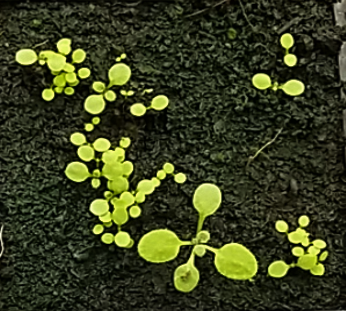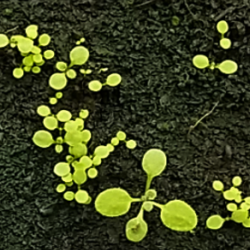
In some environments there is no way for a seed to know for sure when the best time to germinate is.
In spring, cues like light, temperature and water may suggest to seeds that conditions are optimal for germination, but a week later an unpredictable drought or frost could kill the emerging seedlings.
So how does a plant make sure that all of its offspring are not killed at once by an ill-timed environmental stress following germination?
There is evidence that some plant species produce seeds that germinate at different times to hedge their bets against this risk. Many species produce seeds that can enter a dormant state and exist in the soil for several years and some also produce seeds that germinate at different times within a season.
This means that if lethal environmental fluctuations do occur, a fraction of a plant’s offspring will survive as seeds, which can go on to germinate at another time.
This variability in germination time can be seen even with genetically identical seeds grown in an identical environment.
In agriculture, the variability in germination time can be a problem when you want to harvest the whole crop at the same time. Instead, farmers have to monitor their crops’ maturity, taking measurements from multiple individual plants to estimate when the best time is to harvest.
Scientists at the Sainsbury Laboratory Cambridge University (SLCU) used the model plant, thale cress (Arabidopsis thaliana), to ask: What makes genetically identical seeds germinate at different times?
“We already know that two plant hormones – abscisic acid (ABA) that inhibits germination and gibberellic acid (GA) that promotes germination – interact with each other to control the decision to germinate, but we wanted to know how this interaction creates variability in germination times between seeds”, said Dr Katie Abley, researcher at SLCU and joint first author of the research published in eLife.
“By measuring the levels of variability in germination times for hundreds of genetically distinct strains of Arabidopsis, we were able to identify two regions of DNA (genetic loci) that control how variable germination time is. Both loci contain genes that influence how sensitive seeds are to ABA and testing mutants of these genes provided evidence that they regulate variability in germination timing.”
Using this new information, the researchers generated a mathematical model of the ABA-GA network to understand how the interactions between ABA and GA could cause a batch of identical seeds to have a range of germination times. They wanted to understand how the network could give rise to different levels of variability in germination time.
“We found that changing ABA sensitivity in the model replicated the experimental germination time distributions that we observed”, explained Dr Pau Formosa-Jordan, joint first author and now research group leader at Max Planck Institute for Plant Breeding Research in Cologne, Germany. “In the model, groups of seeds with higher sensitivity to ABA germinate in a more spread-out way because, upon sowing, each one of these seeds relies on stochastic fluctuations in the ABA-GA network to switch from a non-germination state to a germination state – which is known as a bistable switch behaviour. Yet, seeds with lower sensitivity to ABA more rapidly and synchronously get to the germination state after being sown, without the need for the stochastic fluctuations. Our stochastic model suggests an ABA-GA bistable switch can generate variability in germination times, with the germination time being influenced by stochastic fluctuations in the levels of hormones.”
Above image: Arabidopsis seedlings germinating at different times. Image by Katie Abley.
While the researchers expect there to be other genetic and biophysical effects at play that affect variability in germination time, their findings show that this plant trait is genetically controlled and high or low variability in germination times could, therefore, be specifically selected for in crop breeding programmes or to rehabilitate natural areas with highly variable environments.
Reference
Katie Abley, Pau Formosa-Jordan, Hugo Tavares, Emily Y. T. Chan, Mana Afsharinafar, Ottoline Leyser, James C. W. Locke (2021) An ABA-GA bistable switch can account for natural variation in the variability of Arabidopsis seed germination time, eLife.
DOI: https://doi.org/10.7554/eLife.59485
Funding
This research was supported by the Gatsby Charitable Foundation.






